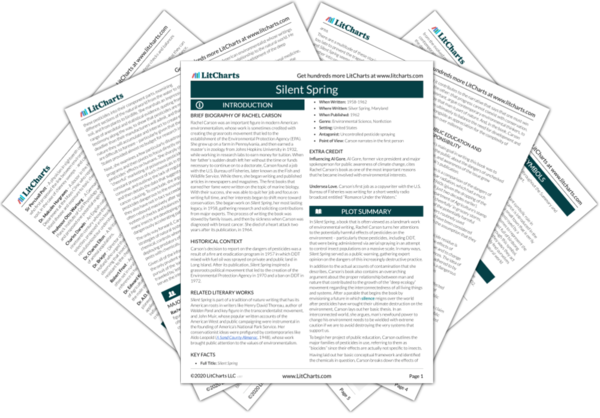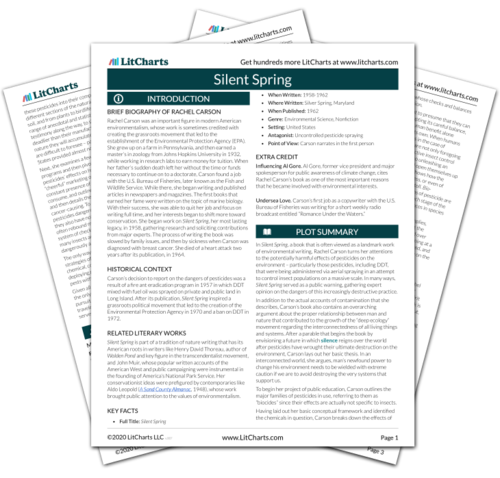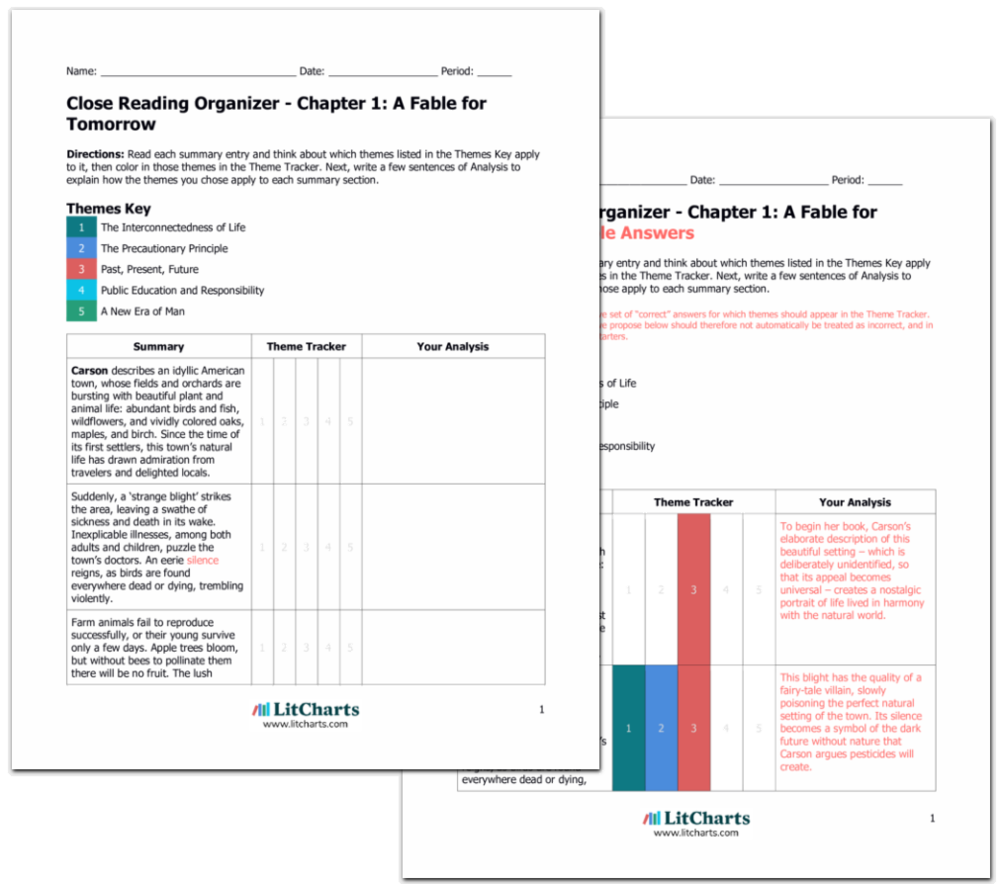
Welcome to the LitCharts study guide on Rachel Carson's Silent Spring. Created by the original team behind SparkNotes, LitCharts are the world's best literature guides.
Rachel Carson was an important figure in modern American environmentalism, whose work is sometimes credited with creating the grassroots movement that led to the establishment of the Environmental Protection Agency (EPA). She grew up on a farm in Pennsylvania, and then earned a master’s in zoology from Johns Hopkins University in 1932, while working in research labs to earn money for tuition. When her father’s sudden death left her without the time or funds necessary to continue on to a doctorate, Carson found a job with the U.S. Bureau of Fisheries, later known as the Fish and Wildlife Service. While there, she began writing and published articles in newspapers and magazines. The first books that earned her fame were written on the topic of marine biology. With their success, she was able to quit her job and focus on writing full time, and her interests began to shift more toward conservation. She began work on Silent Spring , her most lasting legacy, in 1958, gathering research and soliciting contributions from major experts. The process of writing the book was slowed by family issues, and then by sickness when Carson was diagnosed with breast cancer. She died of a heart attack two years after its publication, in 1964.
Get the entire Silent Spring LitChart as a printable PDF."My students can't get enough of your charts and their results have gone through the roof." -Graham S.

Carson’s decision to report on the dangers of pesticides was a result of a fire ant eradication program in 1957 in which DDT mixed with fuel oil was sprayed on private and public land in Long Island. After its publication, Silent Spring inspired a grassroots political movement that led to the creation of the Environmental Protection Agency in 1970 and a ban on DDT in 1972.
Silent Spring is part of a tradition of nature writing that has its American roots in writers like Henry David Thoreau, author of Walden Pond and key figure in the transcendentalist movement, and John Muir, whose popular written accounts of the American West and public campaigning were instrumental in the founding of America’s National Park Service. Her conservationist ideas were prefigured by contemporaries like Aldo Leopold ( A Sand County Almanac , 1948), whose work brought public attention to the values of environmentalism.
Key Facts about Silent SpringInfluencing Al Gore. Al Gore, former vice president and major spokesperson for public awareness of climate change, cites Rachel Carson’s book as one of the most important reasons that he became involved with environmental interests.
Undersea Love. Carson’s first job as a copywriter with the U.S. Bureau of Fisheries was writing for a short weekly radio broadcast entitled “Romance Under the Waters.”
Cite This Page Download this Chart (PDF)
“Would not have made it through AP Literature without the printable PDFs. They're like having in-class notes for every discussion!”
Get the Teacher Edition
“This is absolutely THE best teacher resource I have ever purchased. My students love how organized the handouts are and enjoy tracking the themes as a class.”
Copyright © 2024 All Rights Reserved Save time. Stress less.AI Tools for on-demand study help and teaching prep.
 Quote explanations, with page numbers, for over 44,163 quotes.
Quote explanations, with page numbers, for over 44,163 quotes. PDF downloads of all 1,996 LitCharts guides.
PDF downloads of all 1,996 LitCharts guides. Expert analysis to take your reading to the next level.
Expert analysis to take your reading to the next level. Advanced search to help you find exactly what you're looking for.
Advanced search to help you find exactly what you're looking for.
 Expert analysis to take your reading to the next level.
Expert analysis to take your reading to the next level. Advanced search to help you find exactly what you're looking for.
Advanced search to help you find exactly what you're looking for.